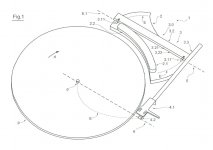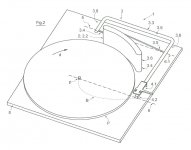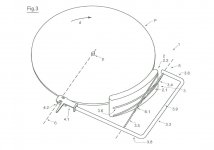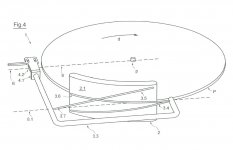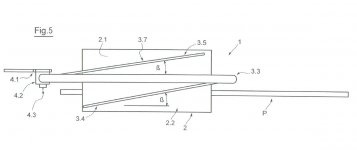Looks like a well made Tonearm. I guess for very wide offset as seen in video controlling with servo would be easy but for minor offset the reaction time would be small and not that much useful right ? Instead why not use a straight simple shaft where tonearm moves in linear way and a silent stepper motor to move the tonearm across the vinyl as per speed selected. One can attach sensor to platter to adjust speed of movement. Practical ?
Regards.
Regards.
"These two negative effects sum together, and we should expect this type of servo action to further compromise wow performance on eccentric discs." This effect does not depend on the servo. Every tonearm based on the Birch geometry or similar must behave so.
Last edited:
"These two negative effects sum together, and we should expect this type of servo action to further compromise wow performance on eccentric discs." This effect does not depend on the servo. Every tonearm based on the Birch geometry or similar must behave so.
Yes, you are correct!
Last edited:
... Instead why not use a straight simple shaft where tonearm moves in linear way and a silent stepper motor to move the tonearm across the vinyl as per speed selected. One can attach sensor to platter to adjust speed of movement. Practical ?
Regards.
You have just described a traditional servo controlled linear/radial/tangential tracking arm, which is off topic. The OP in this thread stated that the intent was to explore ways of achieving tangency without using an air pump or servo.
Ray K
Although I don't like tracking off-centered disc with the arm wandering back and forth, I wonder if that's really the case in the Reed 5T arm since the platter is rotating slower than normal speed. It sure is good for cueing! Not sure if the servo or motor response time is in unison with actual speed at 33rpm. The exaggerated off-center disk rotating at half or a third of 33rpm is obviously for demo. I would like to see a video of the arm in real action playing an off-centered disk at 33rpm and observe the arm movement. I still think exact tracking of eccentricity in a servo arm is not a good idea (due to my nightmare with the Pioneer PL-L1000). I think Rabco got the right idea.
One advantage of the Birch geometry is that the servo light receptacle is at a stationary spot which makes it simpler and easier for alignment. The bulk of the Reed arm makes it not that much compact comparing to a traditional servo arm a la Rabco. Kudos to Reed for exploring alternatives in the commercial market.
One advantage of the Birch geometry is that the servo light receptacle is at a stationary spot which makes it simpler and easier for alignment. The bulk of the Reed arm makes it not that much compact comparing to a traditional servo arm a la Rabco. Kudos to Reed for exploring alternatives in the commercial market.
As alighiszem astutely pointed out, the wow effect is a consequence of the Birch geometry. Even if the servo tracked perfectly, the pivot trajectory would still compromise the wow effect of the eccentricity. Note too that the eccentricity itself introduces an element of tracking error by skewing the groove at the point where an arm and stylus might otherwise be 'perfectly aligned' geometrically.
The point on servo response time is an interesting topic and gets into many debatable tradeoffs. I agree that servo's should not be tuned to track eccentricities.
The other advantage of a servo driven Birch arm is that it would be free of skating effects.
Ray K
The point on servo response time is an interesting topic and gets into many debatable tradeoffs. I agree that servo's should not be tuned to track eccentricities.
The other advantage of a servo driven Birch arm is that it would be free of skating effects.
Ray K
Thanks, Ray and alighiszem for the insight. You're right. Basically any multi linkage arm or Birch variant that changes the arm length from main pivot point to stylus tip during play, the pushing and pulling on the same vector, would affect groove velocity on an eccentric record, however microscopically. Sigh... eccentricity seems to be the devil in the detail! Now I wonder how it would affect the sound in audiophile terms...
Hey, at least there's no air pump!
Hey, at least there's no air pump!
Funk Firm AK1
Thank for the link, Jim!
Very interesting arm and the Funk Firm AK1 certainly fits the subject of this thread. Looks like another Garrard Zero 100 variant... on steroid. It seems well thought out and it should since it cost $24K! We'll keep an eye on its development and look forward to more available info. Perhaps the inventor is a Star Trek fan as it looks like the Enterprise ship!
My only concern is the height of the two pivots, the main arm pivot and the string pulley. Both are stationary but the headshell end moves up and down so when it encounters warp it creates a twist horizontally to compensate the discrepancy of the length of main arm and string which can affect the stylus angle. The Thales tonearm does not have this issue due its bearing design as the main arm bearing is tied to the guiding mechanism dynamically.

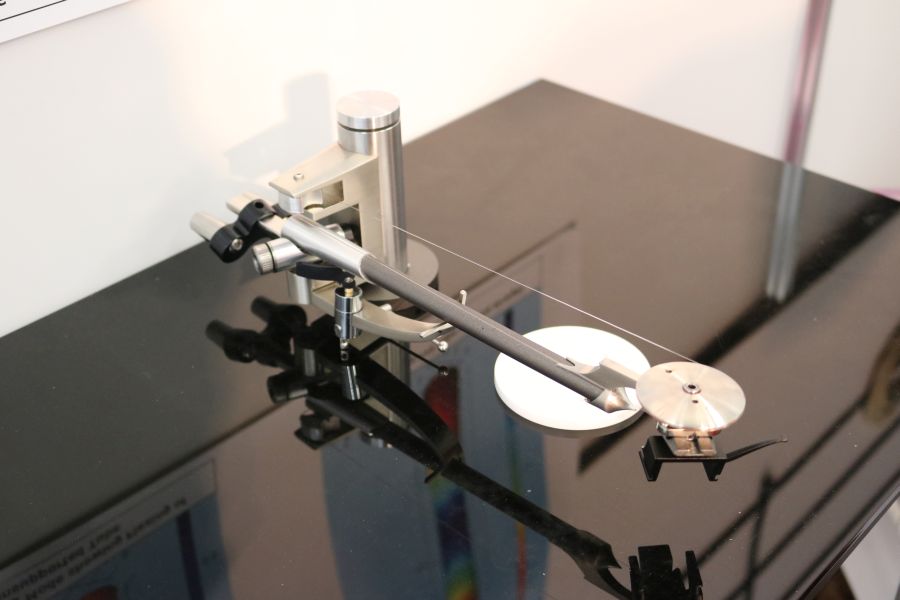
===============================================
The Funk Firm Ak1 also reminds me of the Schuchtronic tonearm in post#467
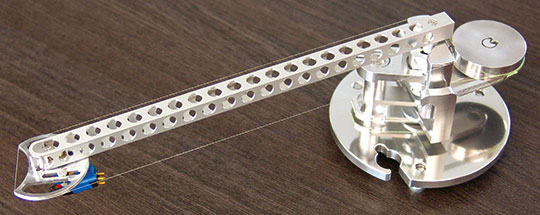

Thank for the link, Jim!
Very interesting arm and the Funk Firm AK1 certainly fits the subject of this thread. Looks like another Garrard Zero 100 variant... on steroid. It seems well thought out and it should since it cost $24K! We'll keep an eye on its development and look forward to more available info. Perhaps the inventor is a Star Trek fan as it looks like the Enterprise ship!
My only concern is the height of the two pivots, the main arm pivot and the string pulley. Both are stationary but the headshell end moves up and down so when it encounters warp it creates a twist horizontally to compensate the discrepancy of the length of main arm and string which can affect the stylus angle. The Thales tonearm does not have this issue due its bearing design as the main arm bearing is tied to the guiding mechanism dynamically.
An externally hosted image should be here but it was not working when we last tested it.


===============================================
The Funk Firm Ak1 also reminds me of the Schuchtronic tonearm in post#467


Last edited:
Schuchtronic tangential tonearm 2017
Looks like Schuchtronic completely dispense the pivot headshell tonearm and created another "string" tonearm with a different concept. Very unique and nothing quite like it! Check out the two YouTube videos below:
"Zero tracking error turntable arm 001"
"Zero tracking error turntable arm 002"
The patent is in German, in case you want to study it.
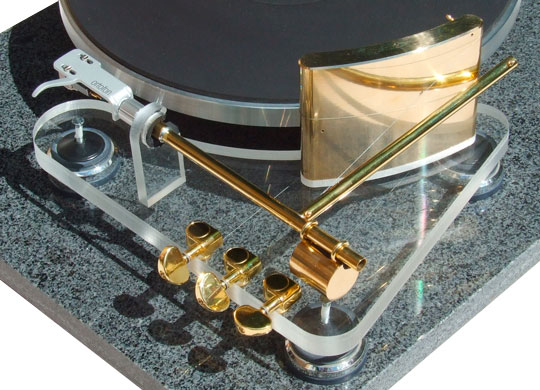
Looks like Schuchtronic completely dispense the pivot headshell tonearm and created another "string" tonearm with a different concept. Very unique and nothing quite like it! Check out the two YouTube videos below:
"Zero tracking error turntable arm 001"
"Zero tracking error turntable arm 002"
The patent is in German, in case you want to study it.

I can't say that I fully understand how the arm works. But as long as the driving force is generated by the interaction of cantilever and groove, the cantilever will endure stress. The question is how much. The only kind of arm will not put stress on the cantilever is an active servo arm with precision eccentricities tracking.
Not tracking eccentricity is a compromise due to lack of appropriate technology. In theory, not tracking has no advantages over tracking. In reality, not tracking may have the advantages over tracking, however, it is a compromise.
Air bearing does track eccentricity passively. For air bearing arm, to find a right combo of cartridge compliance, right damping, right mass and right construction will reduce cantilever stress to avoid under shoot and over shoot.
Not tracking eccentricity is a compromise due to lack of appropriate technology. In theory, not tracking has no advantages over tracking. In reality, not tracking may have the advantages over tracking, however, it is a compromise.
Air bearing does track eccentricity passively. For air bearing arm, to find a right combo of cartridge compliance, right damping, right mass and right construction will reduce cantilever stress to avoid under shoot and over shoot.
I looked at the YouTube videos and the patent. Don’t know German but you can get the gist of how it works from the patent drawings. It does appear to be different. Figure 1 is an implementation with rollers (3.11) and is good for visualizing the concept. Stylus trajectory would be determined by the curve characteristic of (2.2).
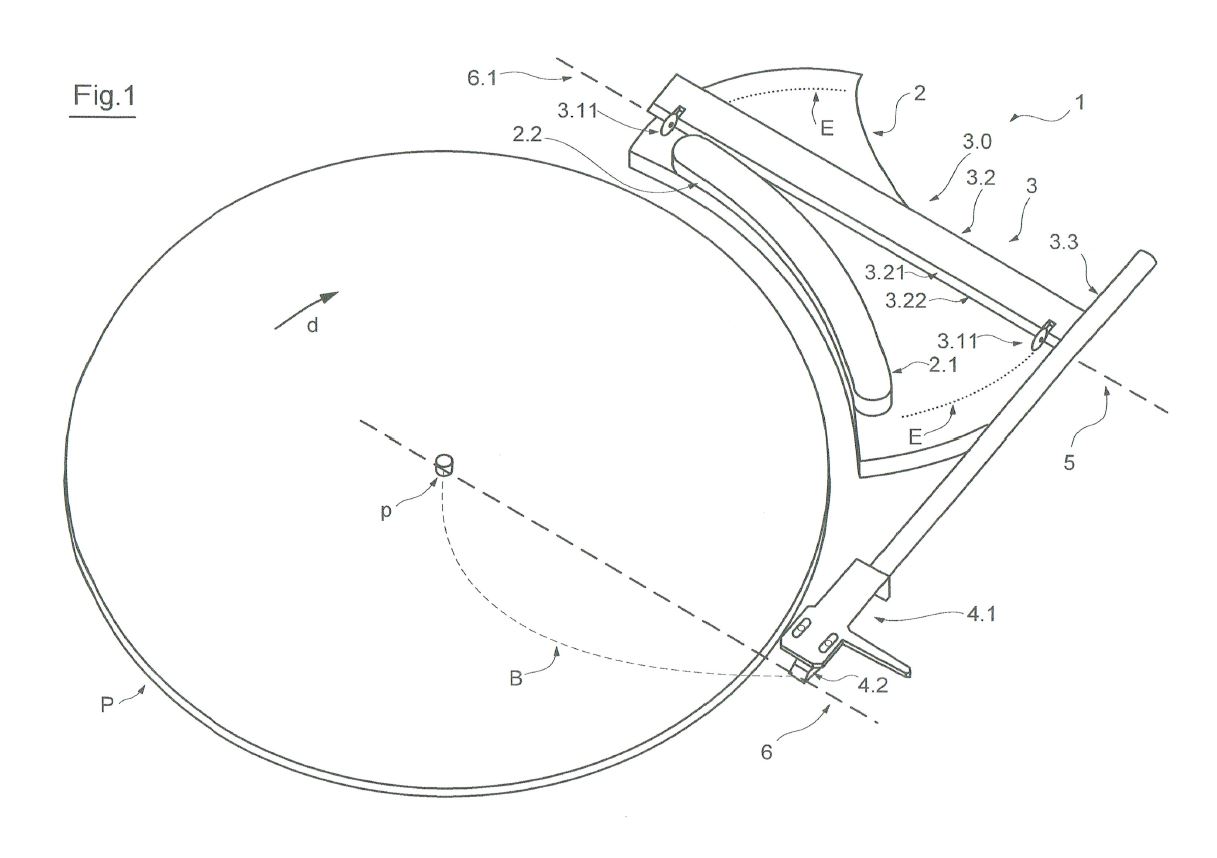
Figures 2, 3 and 4 look like the production model, except that the production model appears to have an added refinement in that the rear rod rests directly on the curved ‘wall’ (2) and does not rely on string tension alone to restrain fore/aft movement of the entire arm.

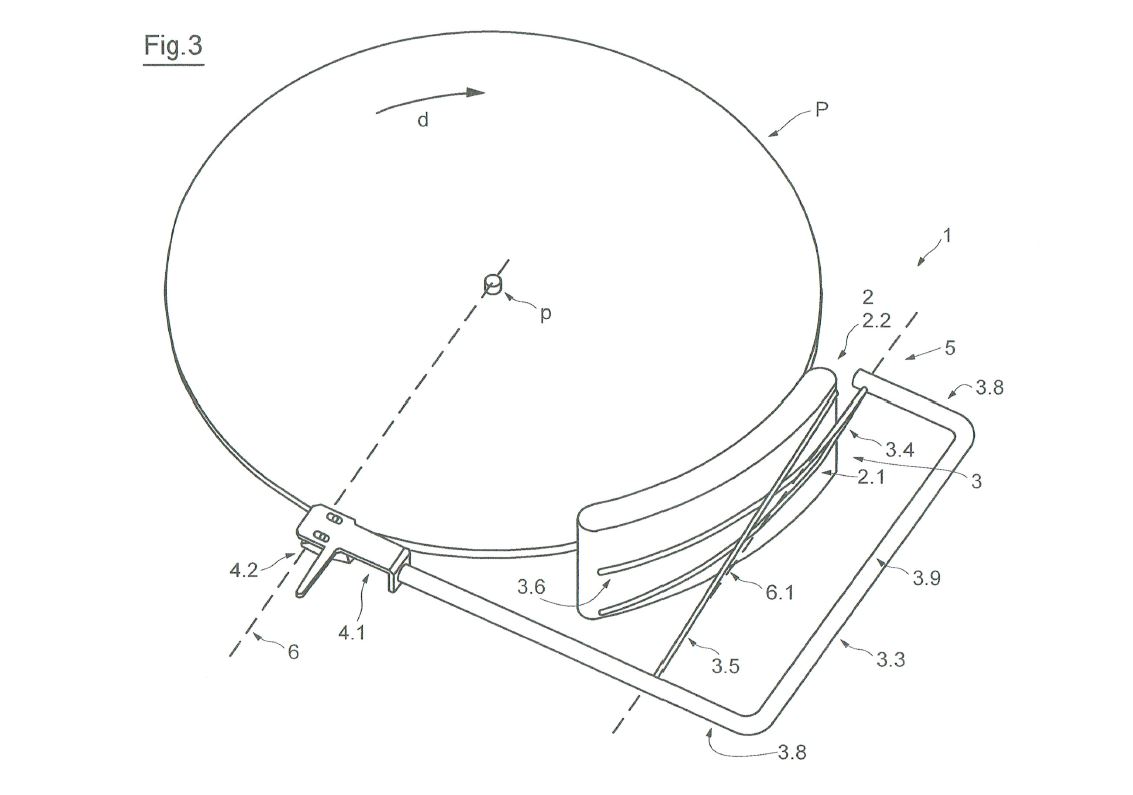
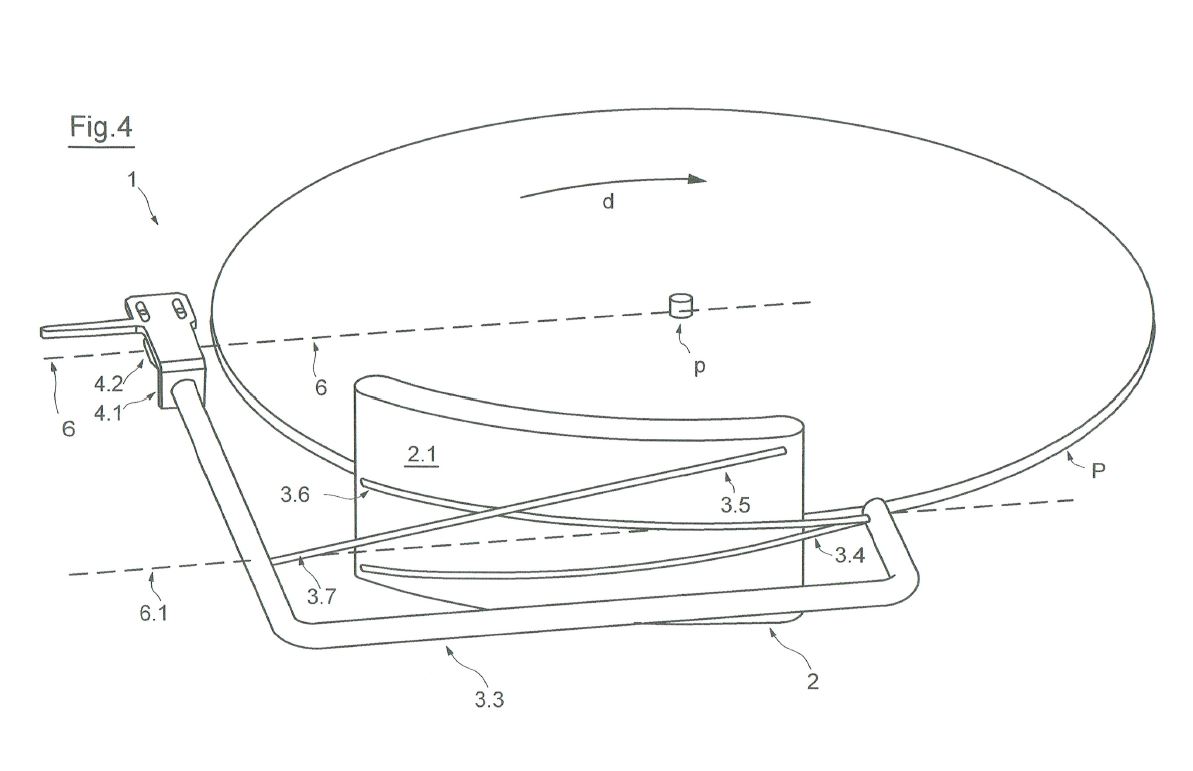
Figure 5 was the ‘light bulb turning on’ showing how the vertical pivot was implemented. The vertical pivot axis is between the left end of string (3.7) and the right end of string (3.4). The relative tension of these would determine pivot height and cartridge azimuth. The tension of these two strings holds the back rod against the curved surface of ‘wall’ (2), and forms a pseudo horizontal pivot that ‘rolls’ along the backside of (2). There is a third string adjustment in the post #1191 photo that I haven’t figured out yet. Anyone?
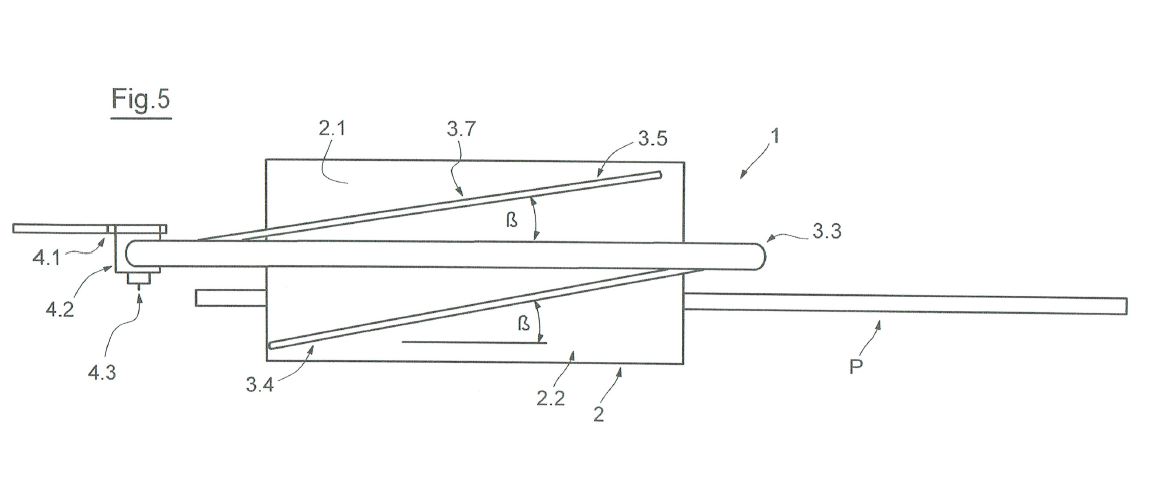
I have concerns about strings (3.7) and (3.4) under tension vibrating as in a guitar or piano, but there is something that concerns me more. Note that the effective offset angle of the arm varies considerably across the disc playing area as the arm’s vertical pivot ‘rolls’ on the curved wall. Just eyeballing the dimensions in the photograph, the effective offset angle at the outer grooves looks like it could be something on the order of 40 degrees, which would make for some horrendous skating forces and cantilever stress. Does anyone see anti-skate compensation anywhere? I don't.
Ray K
Figures 2, 3 and 4 look like the production model, except that the production model appears to have an added refinement in that the rear rod rests directly on the curved ‘wall’ (2) and does not rely on string tension alone to restrain fore/aft movement of the entire arm.
Figure 5 was the ‘light bulb turning on’ showing how the vertical pivot was implemented. The vertical pivot axis is between the left end of string (3.7) and the right end of string (3.4). The relative tension of these would determine pivot height and cartridge azimuth. The tension of these two strings holds the back rod against the curved surface of ‘wall’ (2), and forms a pseudo horizontal pivot that ‘rolls’ along the backside of (2). There is a third string adjustment in the post #1191 photo that I haven’t figured out yet. Anyone?
I have concerns about strings (3.7) and (3.4) under tension vibrating as in a guitar or piano, but there is something that concerns me more. Note that the effective offset angle of the arm varies considerably across the disc playing area as the arm’s vertical pivot ‘rolls’ on the curved wall. Just eyeballing the dimensions in the photograph, the effective offset angle at the outer grooves looks like it could be something on the order of 40 degrees, which would make for some horrendous skating forces and cantilever stress. Does anyone see anti-skate compensation anywhere? I don't.
Ray K
Attachments
Thanks for doing all the leg work, Ray! At first the figure 1 picture looks familiar and it reminds me of something I saw in a patent so I went back to past posts and then I realized the new Schuchtronic arm has a predecessor!
Here's an arm conceptualized by an inventor from India, Dwipendra N. Guha, in patent US3973778 and it's covered from post#288 to post#294. And the consensus is that an arm like that would skate like crazy! And Straight Tracker, Ralf, wagered that Guha never made even a prototype. It's agreed that geometrically the Guha arm is also a Birch variation.


I never figured out how the Guha arm works and I eventually forgot about it. And now the Schuchtronic arm is even more bewildering. At least Schuch made a prototype. I'm not sure how it overcomes skating force. But I love this kind of thinking outside of the box inventions! This thread is about creativity and intellectual amusement. It's fun and thanks for indulging me!
Here's an arm conceptualized by an inventor from India, Dwipendra N. Guha, in patent US3973778 and it's covered from post#288 to post#294. And the consensus is that an arm like that would skate like crazy! And Straight Tracker, Ralf, wagered that Guha never made even a prototype. It's agreed that geometrically the Guha arm is also a Birch variation.


I never figured out how the Guha arm works and I eventually forgot about it. And now the Schuchtronic arm is even more bewildering. At least Schuch made a prototype. I'm not sure how it overcomes skating force. But I love this kind of thinking outside of the box inventions! This thread is about creativity and intellectual amusement. It's fun and thanks for indulging me!
I thought at first sight that the gold/brass curved piece was a hipflask!
...and toned arm.


Last edited:
early AK1 or AK1/2?
I found a picture in another forum of an early developmental model of the Funk Firm AK1 in 2015 and it was called the Grand Prix tonearm. Looks similar to the current one but the strings are crisscrossed. The discussion unfortunately focused too much on its exorbitant price. I'm glad this forum talks more about designs and ideas than pricing and marketing.
The surprising information is that the arm is the result of an early collaboration with the designer of the early Schuchtronic tonearm, the stringed pivoting headshell one, not the string tensioned 'hipflask' one. This Daniel Schuch guy apparetly loves playing with strings!

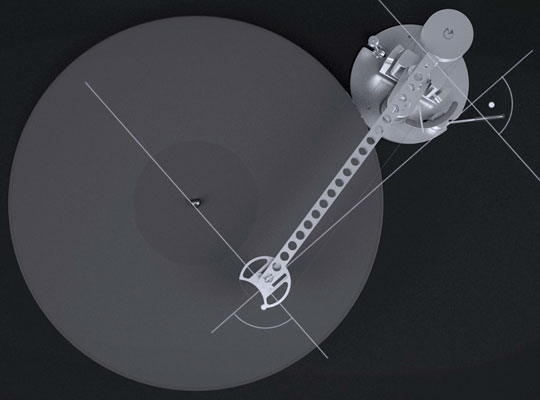
Maybe a revival of another stringed arm.... the DIY way!

I found a picture in another forum of an early developmental model of the Funk Firm AK1 in 2015 and it was called the Grand Prix tonearm. Looks similar to the current one but the strings are crisscrossed. The discussion unfortunately focused too much on its exorbitant price. I'm glad this forum talks more about designs and ideas than pricing and marketing.
The surprising information is that the arm is the result of an early collaboration with the designer of the early Schuchtronic tonearm, the stringed pivoting headshell one, not the string tensioned 'hipflask' one. This Daniel Schuch guy apparetly loves playing with strings!
The actual inspiration for that visually obvious feature (string) was a German arm exhibited at Munich in 2013 by Daniel Schuch. Daniel and Arthur discussed collaboration, but nothing came of it. The problem with the Schuh arm was that whilst it achieved the geometry, structurally it was "less effective". AK had his ideas for tackling the structural issues, which are the core of the F1 idea, but without wanting to be too coy "the gizmo" even more than the materials works well with this variable geometry idea.


Maybe a revival of another stringed arm.... the DIY way!

Last edited:
A couple of thoughts about the Schuchtronic and Guha arms: The Schuchtronic is so goofy/unique that I really hope it works despite one or two theoretical problems. From a DIY perspective, how can anybody not get a kick out of guitar string tuners repurposed despite concerns about string resonances?
The double bearing arm in Fig. 1 is clever, but will probably have binding issues between the bearings sides and the groove sides. That can be mitigated with very precise wheels and grooves, but that puts the construction well outside most DIY. I'd liked to have been around when Daniel Schuch realized he might be able to achieve the same design with strings. In both designs, he seems to have used an elliptical arc - Schroeder - instead of a circular arc - Birch - which might lead to nearly perfect tangency. I share Ray K's concern about the offset. I wonder if there might be a virtual pivot that alleviates that problem.
Without string 3.6, the whole thing will collapse. It provides the second leg of the triangle that supports the outside end of that segment of the arm.
I thought the Guha arm rotated control point B in the Birch geometry 90 degrees and a quick drawing I did yesterday seemed to confirm that, but today, after doing another drawing, it's clearer that the control arm slip/slides across the circular surface. One advantage the Guha arm would have over the Birch is that the plinth could be smaller although it shares the disadvantage of the headshell being parked quite close to the platter edge.
The double bearing arm in Fig. 1 is clever, but will probably have binding issues between the bearings sides and the groove sides. That can be mitigated with very precise wheels and grooves, but that puts the construction well outside most DIY. I'd liked to have been around when Daniel Schuch realized he might be able to achieve the same design with strings. In both designs, he seems to have used an elliptical arc - Schroeder - instead of a circular arc - Birch - which might lead to nearly perfect tangency. I share Ray K's concern about the offset. I wonder if there might be a virtual pivot that alleviates that problem.
Without string 3.6, the whole thing will collapse. It provides the second leg of the triangle that supports the outside end of that segment of the arm.
I thought the Guha arm rotated control point B in the Birch geometry 90 degrees and a quick drawing I did yesterday seemed to confirm that, but today, after doing another drawing, it's clearer that the control arm slip/slides across the circular surface. One advantage the Guha arm would have over the Birch is that the plinth could be smaller although it shares the disadvantage of the headshell being parked quite close to the platter edge.
Last edited:
- Home
- Source & Line
- Analogue Source
- Angling for 90° - tangential pivot tonearms
